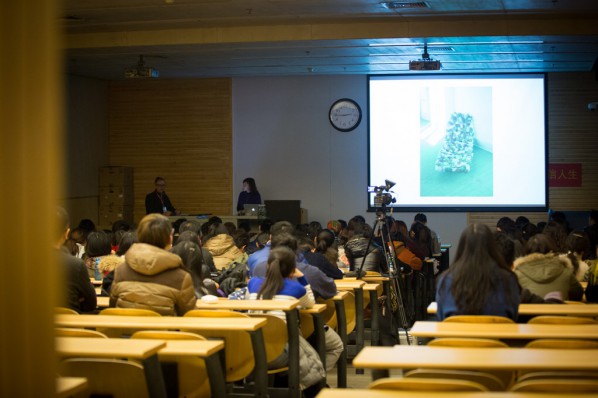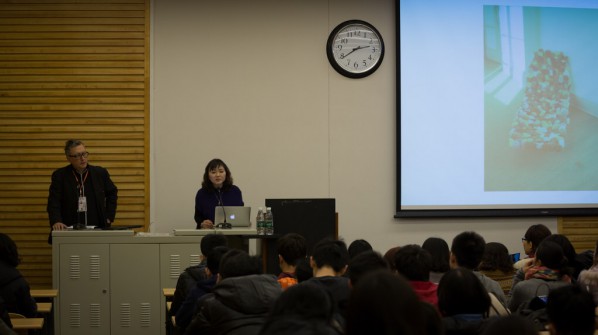
The first session of the 6th “Design for Sitting Exhibition” series of lectures invited Walkersville, Vice President of Staatliche Akademie der Bildenden Künste Karlsruhe and the famous Japanese architect and product designer Masayuki Kurokawa to give a lecture at B114 in Building 7, CAFA at 2:30 pm on January 19, 2014.
Walkersville: Reforming! Upgrading!
Walkersville gives a lecture themed: Reforming! Upgrading! On the issue of reproduction of life waste materials, he combined many practical cases to talk about his thoughts. In our daily life a lot of waste materials are produced, such as plastics, wood, etc., but many productions of recycling waste were low-end and cheap, failing to perfectly realize the value of materials. Currently many designers are committed to reuse waste for design, making the reproduced materials more sophisticated and created high-level outstanding designs which contain a technology and aesthetic connotation. In the early 1980s, some design works in Germany and Europe showcased the trend. For example, a designer simply cut a shopping cart and made a chair with wheels. “100 Chairs in 100 Days” by designer Martino Camper who won the First Furniture Design Prize from the London Design Museum. In accordance with the concept of “there’s not any perfect chair”, he collected many waste chairs and recombined them into a new series of chairs. In fact, the creative applications were full of life in addition to using specific design products.
Currently by reproducing waste materials many excellent products achieved a higher value than the original products. After processing the waste products the original using attribute of the material was completely changed, extending towards a new direction. Walkersville finally concluded: as a designer, one should pay attention to the environment always thinking about the world, so as to create a marvellous design which was beneficial to human development.

Masayuki Kurokawa: Thinking of Chair
Masayuki Kurokawa gave a lecture around “Chair”, and then expounded his design philosophy. He believed that art and design were an interrelated unified entity rather than separate individuals. Design was a philosophy that not only needed to be creative, but also requires to contain thoughts and ideas. A good designer should think of three points including art, technology and industry. In addition, the theory should be integrated with the product, and a designer must have a strong mind to achieve the realm of beauty of the product. The design was like a pyramid, the bottom of its base was work and theory, both supporting the desire to achieve the goal of “beauty” which contained life, order, and truth.
Masayuki Kurokawa thought that the philosophy of a chair contained several aspects: firstly thinking of the property of the object, people were outside the object, in the space, while the object was surrounded by the mental aura, all made up the environment. When people lived in the object, it constituted a city. Seen from the outside, architecture was an object, but it was a space when people were inside it, thus it has a duality. Chair and building were similar, space evolved into them while they contain space, which has a duality of space and object. Similar ideas might answer the reason why many architectural masters were keen on the design of a chair, many excellent architects such as Gerrit Thomas Rietvel, Frank Owen Gehry, etc., have outstanding designs of chairs. Secondly, the love of Buddha was divided into kindness and compassion. Love of kindness meant sacrifice, which was similar to a mother’s love. Love of compassion was more like a father’s love. When a chair was facing you, it was like a mother opening her arms to embrace you, giving you warm comfort. When it showed this side to you, it was like a man’s back, as stern and silent as a father. Two different feelings were combined in a chair, while different angles give people different feelings.
Masayuki Kurokawa also put forward that it was necessary to combine interest and play in the process of the design of a chair. The essence of Japanese and European designs were different, such as clothing, European suits were tailored according to fit each body shape which wastes a lot of space. Japanese Kimono disagrees with this, although it was not close-fitting, it could be adjusted to the figure. For Masayuki Kurokawa, it was a peaceful feeling when a chair appeared in an empty and silent space, while this security was the core of his design. At the end of the lecture, Masayuki Kurokawa concluded: design was not only a performance, but also a game of hide and seek.
When he was asked about the issues of the quality of waste recycling and the cost of the producing process, Walkersville replied, as a designer, one should initially know where the waste can be used, and secondly, it was necessary to study how to use it. Thus after collecting these materials, they would experience a series of processes including disinfection and cleaning. This was a new understanding rather than going for a cheaper version, it was a new idea that refused to waste any new resources. After reproduction such environmental conscious products have improved sales, and the price is higher than ever before, because a lot of people like to pay for this new idea in Europe.
Journalist: Zhang Gaoshan, Photo: Wei Wei/CAFA ART INFO
Translated by Chen Peihua and edited by Sue/CAFA ART INFO




























